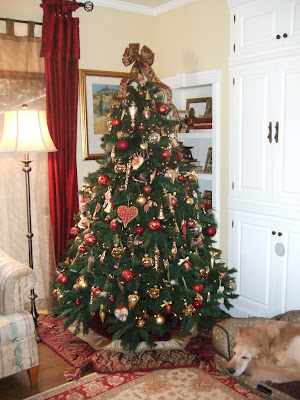この時期になるといつも心温かくなります。何故か子供みたいにウキウキするんだよね~。でも悪くないと思うw 英語ではこの時期を"Time of giving"とよく言います、なので人を助ける、寄付をするなど自分で出来ることをしています。良く言葉では説明できないんですがクリスマスの時期は人のよいところをすごく引き出してくれる気がします。今日はクリスマスツリーの由来についてちょっと。
 |
| 今年のツリー |
クリスマスツリーをクリスマスに飾る風習が最初に記録されたのは1419年、ドイツのフライブルクという町 で。パン職人の信心会が聖霊救貧院にツリーを飾ったのが最初といわれています1600年代にはドイツ各地で記録が残されています。ベルリンには1800 年頃にツリーが伝わり、イギリスへは19世紀に伝わっています。そんなに古いことではありませんね。アメリカ合衆国で最初のツリーはドイツ移民によって 1746年に飾られました。やはりドイツがクリスマスツリー発祥の地ですね。
 |
| Victorian Christmas |
厳しいヨーロッパの冬は一面真っ白な雪に覆われ、その中でも葉を失わない常緑樹は、永遠の命の象徴とされ、尊ばれました。 ドイツ地方の信仰ではそんなもみの木に花や食べ物を飾って、木に宿る小人がとどまって力を与えてくれるというものがありました。また、宗教改革で知れるマルチン.ルターが礼拝の帰りに常緑樹の間にきらめく星の美しさに心を打たれ、子供たちのために再現しようと家の中にもみの木を持ち込み、火のついたろうそくを飾ったことがイルミネーションの由来と言われています。
The origin of the Christmas tree is obscured by uncertainties of oral histories of pre-literate European and Asian cultures. For example, according to Christian lore, the Christmas tree is associated with St Boniface and the German town of Geismar. Sometime in St Boniface's lifetime (c. 672-754) he cut down the tree of Thor in order to disprove the legitimacy of the Norse gods to the local German tribe. St. Boniface saw a fir tree growing in the roots of the old oak.
The custom of erecting a Christmas Tree can be historically traced to 15th century Livonia (present-day Estonia and Latvia) and 16th century Northern Germany. According to the first documented uses of a Christmas tree in Estonia, in 1441, 1442, and 1514 the Brotherhood of the Blackheads erected a tree for the holidays in their brotherhood house in Reval (now Tallinn). At the last night of the celebrations leading up to the holidays, the tree was taken to the Town Hall Square where the members of the brotherhood danced around it. In 1584, the pastor and chronicler Balthasar Russow wrote of an established tradition of setting up a decorated spruce at the market square where the young men “went with a flock of maidens and women, first sang and danced there and then set the tree aflame.” In that period, the guilds started erecting Christmas trees in front of their guildhalls: Ingeborg Weber-Kellermann (Marburg professor of European ethnology) found a Bremen guild chronicle of 1570 which reports how a small tree was decorated with "apples, nuts, dates, pretzels and paper flowers" and erected in the guild-house, for the benefit of the guild members' children, who collected the dainties on Christmas Day.
If you'd like to learn more about the history of Christmas trees, check out http://billpetro.com/history-of-christmas-tree


No comments:
Post a Comment